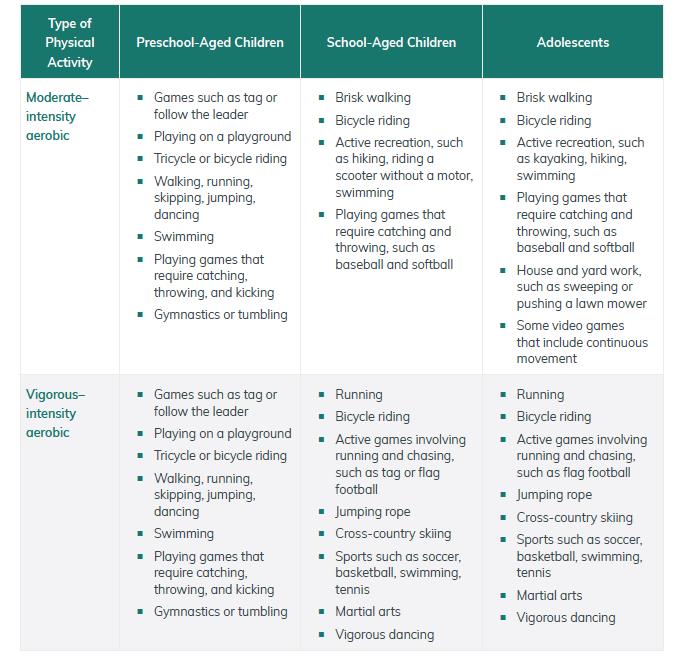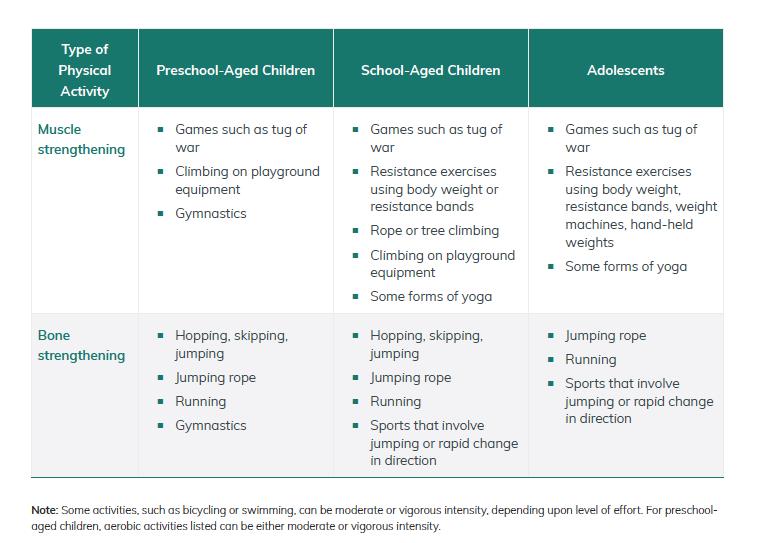 |
|||||||||
This report is based on the most recent (2018) edition of the Physical Activity Guidelines for Americans[1]that reflects the scientific evidence and recommendations of the 2018 Physical Activity Guidelines Advisory Committee.[2] Youth who have both acute bouts and regular moderate-to-vigorous physical activity typically have higher cardiorespiratory fitness levels, stronger muscles, lower body fat, stronger bones, and brain health benefits. School-aged children who are physically active benefit from improved cognition relating to memory, executive function, processing speed, attention, reduced symptoms of depression, and better academic performance. Youth who are regularly active have a better chance of avoiding the precursors of chronic disease, including obesity, elevated insulin, unhealthy blood lipids, and high blood pressure. These conditions are increasingly emerging in children and adolescents and they lead to chronic diseases such as heart disease and diabetes in adulthood. The Guidelines emphasize that “It is important to provide young people opportunities and encouragement to participate in physical activities that are appropriate for their age, that are enjoyable, and that offer variety.” Preschool-aged children (ages 3 through 5 years) should be physically active throughout the day to enhance growth and development. Children and adolescents ages 6 through 17 years should do 60 minutes (1 hour) or more of these types of moderate-to-vigorous physical activity daily:
Aerobic activities are those in which young people rhythmically move their large muscles for a sustained period of time. Running, hopping, skipping, jumping rope, swimming, dancing, and bicycling are examples of aerobic activities. Aerobic activities increase cardiorespiratory fitness. Children often do activities in short bursts, which may not technically be aerobic. However, the Guidelines uses the term aerobic to refer to these types of activities, even if they are done only briefly. Muscle-strengthening activities make muscles do more work than usual during activities of daily life. This is called overload and strengthens the muscles. Muscle-strengthening activities can be unstructured and part of play, such as playing on playground equipment, climbing trees, and playing tug-of-war. Or they can be structured, such as lifting weights or working with resistance bands. Bone-strengthening activities produce a force on the bones of the body that promotes bone growth and strength. This force is commonly produced by impact with the ground. Running, jumping rope, basketball, tennis, and hopscotch are all examples of bone-strengthening activities. They can also be aerobic and muscle strengthening. The tables below from the Physical Activity Guidelines for Americans provide examples of Aerobic, Muscle-, and Bone-Strengthening Physical Activities for Children and Adolescents.
[1] U.S. Department of Health and Human Services. Physical Activity Guidelines for Americans, 2nd edition. Washington, DC: U.S. Department of Health and Human Services; 2018.
[2] 2018 Physical Activity Guidelines Advisory Committee. 2018 Physical Activity Guidelines Advisory Committee Scientific Report. Washington, DC: U.S. Department of Health and Human Services, 2018.
|
|
|||


